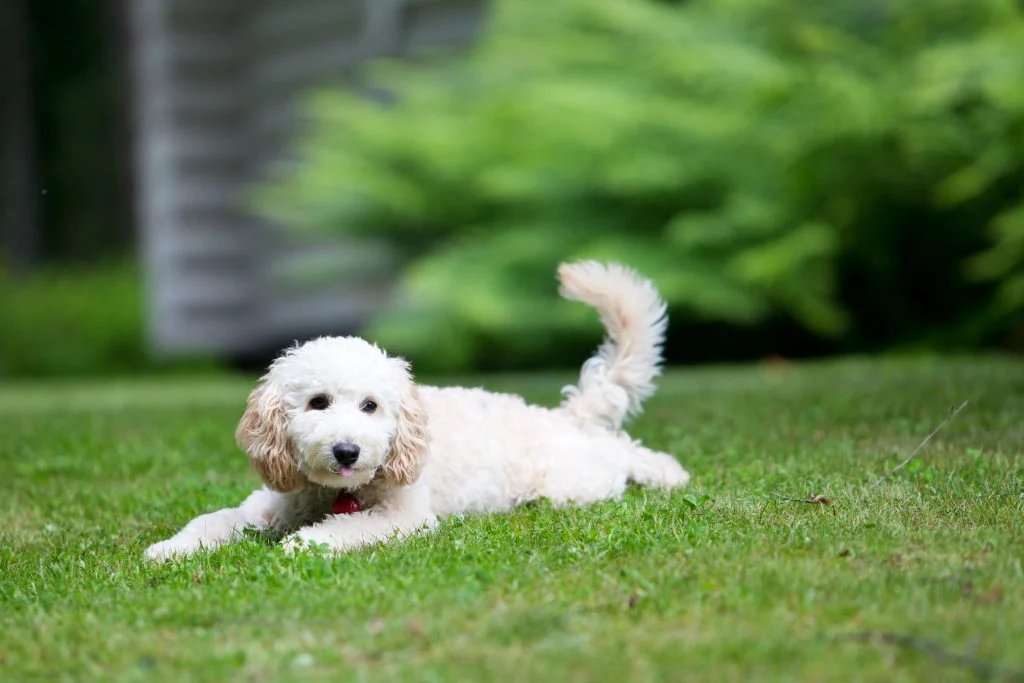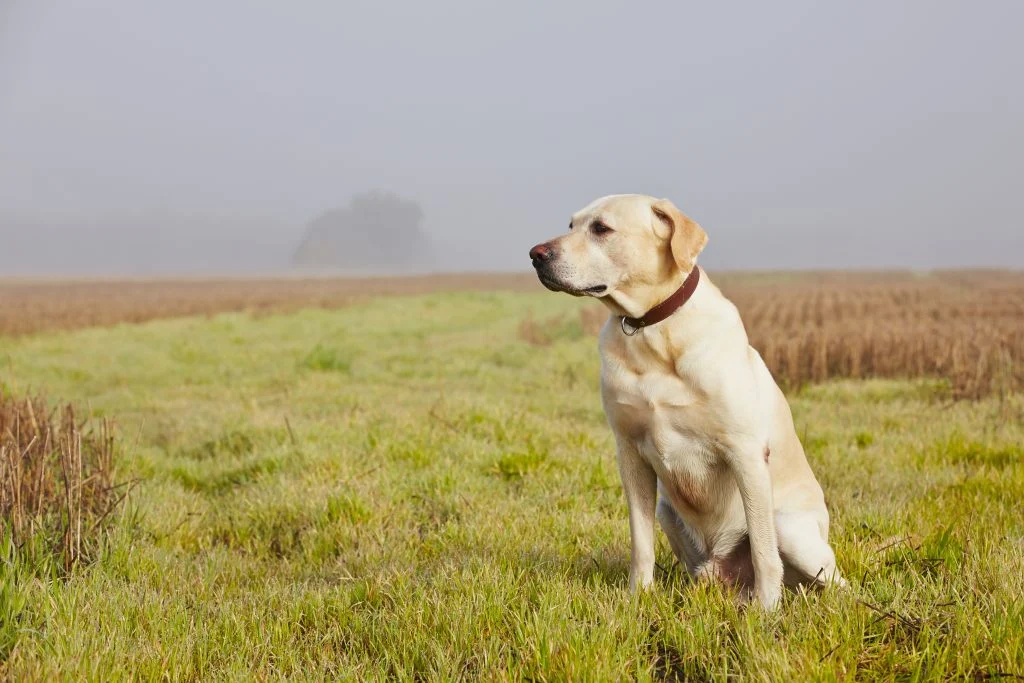Labradoodle
Quick Guide
What Exactly is a Labradoodle?
The Labradoodle is a mixed-breed dog that results from crossing a purebred Labrador Retriever with a purebred Standard Poodle.
Often described and sold as a “designer dog”, the Labradoodle is widely regarded as being one of the first dogs to enter the trending designer dog scene.
While Labradoodles make excellent family pets, it is hard to predict exactly what they will be like as adults because they get their genetics from two very different breeds.
Within a single litter of crossbreed puppies you can have a wide range of different sizes, colors and personalities – there is no way to know what the puppies will be like as adults until they grow up.
Still, you can make certain predictions about the Labradoodle’s size, appearance, personality, and temperament based on the known characteristics of the parent breeds.
Characteristics of a Labrador Retriever
The Labrador Retriever is consistently ranked as the most popular dog breed in America according to AKC registration statistics. This breed was developed as a retriever-gun dog and it is a fairly new breed, having only been developed within the last 200 years. The ancestor of the modern Labrador Retriever was the St. Bernard.
John’s Water Dog which was discovered on the island of Newfoundland in the early 1800s. This early ancestor of the Labrador Retriever breed was admired for its hunting and retrieving ability as well as its excellent swimming skills. The first St. John’s Water Dog was brought to England in 1820 where it was developed into the modern Labrador Retriever, possibly with input from various other retriever breeds.
The modern Labrador Retriever is a large-breed dog that stands between 21 and 25 inches high and weighs anywhere from 55 to 80 pounds at maturity. These dogs have a strong, muscular build with long legs and a deep chest. Labrador Retrievers have short, dense double coats with a soft undercoat and a water-resistant topcoat. The dog’s thick coat protects it against cold water and harsh weather as it carries out its task as a gun dog and water retriever. This breed comes in three AKC-accepted colors – yellow, black, and chocolate – though there is also a fox-red variant of the breed which is typically lumped into the yellow category.
In terms of temperament, Labrador Retrievers are very friendly and outgoing – many Labs, as they are affectionately nicknamed, also have a goofy side. This breed has an excellent sense of smell and natural tracking ability which makes it particularly popular as a search-and-rescue breed, though it can also be used as a therapy or assistance dog. These dogs form strong bonds with family and they do very well around children and most household pets. Labs sometimes bark at noise, though they are generally not very territorial so they don’t make the best watchdogs or guard dogs. If you are looking for a loving family pet, however, this is the perfect breed.
Labrador Retrievers are very intelligent and they take well to training. Unfortunately, their intelligence also makes them susceptible to boredom and a bored Labrador Retriever is often a destructive Labrador Retriever. These dogs are also talented escape artists, often finding ways to escape from locked houses and fenced yards. In terms of health, the Labrador Retriever is a robust breed with relatively few major health problems. Some of the inherited disorders known to affect the breed include hip dysplasia, patellar luxation, progressive retinal atrophy and hereditary myopathy. Labrador Retrievers are also prone to other conditions including obesity, deafness, autoimmune diseases, cataracts, and gastric dilation volvulus.

Characteristics of a Poodle
The Poodle is one of the most easily identified dog breeds out there, known for its thick curly coat. Poodles have a reputation for being high-maintenance and vain, though this is not true for all specimens of the breed. Individual temperament does vary, but personality can be affected by socialization and upbringing. When properly trained and socialized, Poodles can be very friendly and even-mannered dogs that make wonderful family pets. In fact, many Poodles are very patient with children and the breed as a whole gets along well with other dogs and household pets. Many Poodles are quite charming with a bit of a goofy side, providing endless hours of entertainment.
The Poodle is actually a composite of three different breeds divided by size – the Standard Poodle (large), the Miniature Poodle (medium), and the Toy Poodle (small). The main difference between these three breeds is size, though there are some temperament differences between the Standard Poodle and the two smaller sizes. All three Poodle varieties exhibit the curly Poodle coat, however. The Poodle’s coat is unique in that it is a single coat but it is still very dense. The coat of this breed is fine in texture but it grows very fast and it grows very long – frequent brushing and grooming is required to maintain the quality of the coat for this breed. The Poodle is often described as a hypoallergenic breed but it does in fact shed, just a minimal amount. It is also worth noting that the Poodle’s shed hair often gets caught up in the curly coat instead of falling to the ground.
Though many people associate the Poodle with the show ring, the breed was actually developed as a water retriever. The origins of the Poodle can be traced back to German where it was known as the Pudelhund, though the breed was actually standardized in France. The Standard Poodle is the breed type and it was developed for retrieving downed waterfowl from the water. The Miniature Poodle was bred down in size and developed for truffle hunting while the Toy Poodle was primarily kept as a companion pet. The modern Poodle continues to excel as a water retriever and its intelligence makes it a popular choice for various dog sports including agility and obedience. Many Poodles also excel at dock-diving and field tracking.
The Standard Poodle is a gentle and friendly dog that loves to spend time with people – this is not a dog that should be left alone for long periods of time. Miniature and Toy Poodles are a little more high-maintenance in terms of training and they are less patient with children and other dogs. In terms of health, smaller Poodles have been known to live as long as 20 years, though Standard Poodles have a median lifespan closer to 12 years. Standard Poodles are at-risk for many serious health problems including Addison’s disease, von Willebrand disease, gastric dilation volvulus, and hip dysplasia. Toy and Miniature Poodles are more likely to suffer from dental problems and musculoskeletal issues related to their size, though they can also develop skin problems, epilepsy, and various eye problems.
Labradoodle Characteristics and Temperament
The Labradoodle is one of the most popular cross-breed dogs out there. Though genetics do vary, most Labradoodles are known for being very friendly, active, and fun-loving dogs. The Labradoodle is a cross between two purebred dogs, so it is impossible to accurately predict what an adult Labradoodle will be like when it grows up but you can make some assumptions based on the standard characteristics of the two parent breeds. For example, both the Labrador Retriever and the Standard Poodle are fairly sizable dogs so you can expect your Labradoodle to medium in size or larger, somewhere between 40 and 80 pounds. It is possible to breed a Labradoodle from a Toy or Miniature Poodle, however, in which case the resulting dog could be much smaller.
In addition to size, the personality and temperament of the Labradoodle will vary depending on breeding. The Labrador Retriever is one of the friendliest dogs on the planet and the Poodle is very mild-mannered so your Labradoodle will likely tread the line between these two characteristics. Most Labradoodles are people-oriented and eager to please – they can also form very strong bonds with family and become very affectionate. Both Labrador Retrievers and Standard Poodles are great with kids, though Toy and Miniature Poodles may be less tolerant. If your Labradoodle has Standard Poodle blood, he is likely to be a great family pet. Breeding will determine his attitude toward other dogs and household pets as well, though most Labradoodles have no problems in this area.
Labradoodles tend to be very active and energetic dogs so they require a great deal of daily exercise plus plenty of mental stimulation to keep them from becoming bored. The Labradoodle is not a breed that should be left alone for long periods of time, and not only because they are prone to separation anxiety. If your Labradoodle gets bored, he will find ways to amuse himself and you probably won’t like what he comes up with. Some Labradoodles also inherit the Labrador Retriever’s tendency to escape so you should always keep a close eye on your dog when he is outside the home and keep him on a leash during walks. With proper training you can curb most of the Labradoodle’s problem behaviors. It shouldn’t take long because this breed inherits its intelligence from both parents which makes for a very trainable dog.
The appearance of your Labradoodle will vary depending on breeding, but most Labradoodles have soft, wavy coats the range in color from darker shades like brown, black and gray to lighter shades of yellow, tan, or white. The Labradoodle’s coat will vary in length depending how much of its genes it gets from the Poodle parent, though you should expect to brush, groom and trim your Labradoodle fairly often to keep its coat in good condition. In terms of health, the Labradoodle is a fairly robust and healthy breed, though it is prone to certain problems. Both parent breeds are affected by hip dysplasia, gastric dilation volvulus, and inherited eye conditions so these disease may affect your Labradoodle as well. Other conditions that could affect the breed include progressive retinal atrophy, von Willebrand disease, patellar luxation, hypothyroidism, and epilepsy.
How Much Do Labradoodles Cost?
When shopping for a Labradoodle puppy you will probably find a wide range of prices online and you should prepare yourself for the fact that Labradoodles are one of the most expensive “designer dogs”. Even if you get your Labradoodle from a qualified breeder who doesn’t play into the designer dog trend, you could still end up spending as much as $2,000 or more for a Labradoodle puppy. Before you settle on a breeder, however, you should do a little bit of research to determine a fair price. A fair price for Labradoodle puppies can be determined by considering the cost of purebred puppies from both parent breeds as sold by AKC-registered breeders.
A purebred Labrador Retriever from an AKC-registered breeder sells for between $800 and $1,200 which is a fairly low price compared to many purebred dogs. Poodles, on the other hand, can fetch much higher prices for show-quality dogs from AKC-registered breeders. You shouldn’t be surprised to see prices as high as $3,000 for a show-quality Standard Poodle. Miniature Poodles typically fetch prices between $800 and $1,200 – you may also be able to find a pet-quality Standard Poodle within this price range. Given this information, you should never spend more than $3,000 for a Labradoodle puppy, though a price range between $800 and $1,500 is much more reasonable. Avoid buying a Labradoodle puppy from a breeder who makes specific claims in regard to the puppy’s size, appearance, or temperament because these things are nearly impossible to predict with a mixed breed.
What is a Labradoodle’s Lifespan?
Because the Labradoodle is a cross between two different purebred dogs, its lifespan will vary a lot depending on genetics. In order to determine the Labradoodle’s lifespan, you need to consider the lifespan of the two parent breeds. Both parent breeds are medium- to large-sized dogs so they have fairly short lifespans. The average for the Labrador Retriever is 10 to 13 years while the average for the Standard Poodle is 10 to 12. Given this information, you can expect your Labradoodle to live between 10 and 12 years, on average. If your Labradoodle is bred from a Miniature Poodle, his lifespan may be a little longer, closer to 12 to 15 years.
How Big is a Full-Grown Labradoodle?
It is difficult to predict the adult size of a mixed-breed dog like the Labradoodle because the genetics are so variable between the two parent breeds. In the case of the Labradoodle, both parent breeds are medium- to large-sized dogs, so you can expect the Labradoodle to be a fairly sizable dog. An adult Labrador Retriever weighs between 55 and 80 pounds at maturity while an adult Standard Poodle weighs 40 to 55 pounds. Given this information, you can expect your Labradoodle to fall somewhere in the weight range between 40 and 80 pounds at maturity. In cases where your Labradoodle is bred from a Miniature Poodle, however, he may end up being closer to the 30- to 50-pound range. The only way to really know the full-size of your Labradoodle, however, is to wait for him to mature.













THIS ARTICLE WAS AMAZING!!!!!!!!!!!!!!!!!!!!!!!!!!!!!!!! Thanks. 🙂